United States dollar
 Federal Reserve Notes (obverse) | ||
| ISO 4217 | ||
|---|---|---|
| Code | USD (numeric: 840) | |
| Subunit | 0.01 | |
| Unit | ||
| Symbol | $, US$, U$ | |
| Nickname | List
| |
Pegged by | see § Pegged currencies | |
The United States dollar (symbol: $; currency code: USD; also abbreviated US$ to distinguish it from other dollar-denominated currencies; referred to as the dollar, U.S. dollar, American dollar, or colloquially buck) is the official currency of the United States and several other countries. The Coinage Act of 1792 introduced the U.S. dollar at par with the Spanish silver dollar, divided it into 100 cents, and authorized the minting of coins denominated in dollars and cents. U.S. banknotes are issued in the form of Federal Reserve Notes, popularly called greenbacks due to their predominantly green color.
The
The U.S. dollar was originally defined under a
The U.S. dollar became an important international
As of February 10, 2021, currency in circulation amounted to US$2.10 trillion, $2.05 trillion of which is in Federal Reserve Notes (the remaining $50 billion is in the form of coins and older-style United States Notes).[6]
As of September 20, 2023, the Federal Reserve estimated that the total amount of currency in circulation was approximately US$2.33 trillion.[7]
Overview
In the Constitution
Article I, Section 9 of the Constitution provides that "a regular Statement and Account of the Receipts and Expenditures of all public Money shall be published from time to time",[10] which is further specified by Section 331 of Title 31 of the U.S. Code.[11] The sums of money reported in the "Statements" are currently expressed in U.S. dollars, thus the U.S. dollar may be described as the unit of account of the United States.[12] "Dollar" is one of the first words of Section 9, in which the term refers to the Spanish milled dollar, or the coin worth eight Spanish reales.
Coinage Act
In 1792, the U.S. Congress passed the Coinage Act, of which Section 9 authorized the production of various coins, including:[13]: 248
Dollars or Units—each to be of the value of a Spanish milled dollar as the same is now current, and to contain three hundred and seventy-one grains and four sixteenth parts of a grain of pure, or four hundred and sixteen grains of standard silver.
Section 20 of the Act designates the United States dollar as the unit of currency of the United States:[13]: 250–1
[T]he money of account of the United States shall be expressed in dollars, or units...and that all accounts in the public offices and all proceedings in the courts of the United States shall be kept and had in conformity to this regulation.
Decimal units
Unlike the Spanish milled dollar, the Continental Congress and the Coinage Act prescribed a decimal system of units to go with the unit dollar, as follows:[14][15] the mill, or one-thousandth of a dollar; the cent, or one-hundredth of a dollar; the dime, or one-tenth of a dollar; and the eagle, or ten dollars. The current relevance of these units:
- Only the cent (¢) is used as everyday division of the dollar.
- The dime is used solely as the name of the coin with the value of 10 cents.
- The mill (₥) is relatively unknown, but before the mid-20th century was familiarly used in matters of sales taxes, as well as gasoline prices, which are usually in the form of $ΧΧ.ΧΧ9 per gallon (e.g., $3.599, commonly written as $3.59+9⁄10).[16][17]
- The eagle is also largely unknown to the general public.[17] This term was used in the Coinage Act of 1792 for the denomination of ten dollars, and subsequently was used in naming gold coins.
The Spanish peso or dollar was historically divided into eight reales (colloquially, bits) – hence pieces of eight. Americans also learned counting in non-decimal bits of 12+1⁄2 cents before 1857 when Mexican bits were more frequently encountered than American cents; in fact this practice survived in New York Stock Exchange quotations until 2001.[18][19]
In 1854,
When currently issued in circulating form, denominations less than or equal to a dollar are emitted as U.S. coins, while denominations greater than or equal to a dollar are emitted as Federal Reserve Notes, disregarding these special cases:
- Gold coins issued for circulation until the 1930s, up to the value of $20 (known as the double eagle)
- Bullion or commemorative gold, silver, platinum, and palladium coins valued up to $100 as legal tender (though worth far more as bullion).
- Civil War paper currency issue in denominations below $1, i.e. fractional currency, sometimes pejoratively referred to as shinplasters.
Etymology
In the 16th century, Count Hieronymus Schlick of Bohemia began minting coins known as joachimstalers, named for Joachimstal, the valley in which the silver was mined. In turn, the valley's name is titled after Saint Joachim, whereby thal or tal, a cognate of the English word dale, is German for 'valley.'[21] The joachimstaler was later shortened to the German taler, a word that eventually found its way into many languages, including:[21] tolar (
); dalar and daler (Norwegian); daler or daalder (Dutch);Though the
Nicknames
The colloquialism buck(s) (much like the British quid for the pound sterling) is often used to refer to dollars of various nations, including the U.S. dollar. This term, dating to the 18th century, may have originated with the colonial leather trade, or it may also have originated from a poker term.[23]
Greenback is another nickname, originally applied specifically to the 19th-century Demand Note dollars, which were printed black and green on the backside, created by Abraham Lincoln to finance the North for the Civil War.[24] It is still used to refer to the U.S. dollar (but not to the dollars of other countries). The term greenback is also used by the financial press in other countries, such as Australia,[25] New Zealand,[26] South Africa,[27] and India.[28]
Other well-known names of the dollar as a whole in denominations include greenmail, green, and dead presidents, the latter of which referring to the deceased presidents pictured on most bills. Dollars in general have also been known as bones (e.g. "twenty bones" = $20). The newer designs, with portraits displayed in the main body of the obverse (rather than in cameo insets), upon paper color-coded by denomination, are sometimes referred to as bigface notes or Monopoly money.[citation needed]
Nicknames specific to denomination:
- The quarter dollar coin is known as two bits, alluding the dollar's origins as the "piece of eight" (bits or reales).[18]
- The $1 bill is nicknamed buck or single.
- The infrequently-used $2 bill is sometimes called deuce, Tom, or Jefferson (after Thomas Jefferson).
- The $5 bill is sometimes called Lincoln (after Abraham Lincoln), fin, fiver, or five-spot.
- The $10 bill is sometimes called sawbuck, ten-spot, or Hamilton (after Alexander Hamilton).
- The $20 bill is sometimes called double sawbuck, Jackson (after Andrew Jackson), or double eagle.
- The $50 bill is sometimes called a yardstick, or a grant, after President Ulysses S. Grant.
- The $100 bill is called Benjamin, Benji, Ben, or Franklin, referring to its portrait of Benjamin Franklin. Other nicknames include C-note (C being the Roman numeral for 100), century note, or bill (e.g. two bills = $200).
- Amounts or multiples of $1,000 are sometimes called grand in colloquial speech, abbreviated in written form to G, K, or k (from kilo; e.g. $10k = $10,000). Likewise, a large or stack can also refer to a multiple of $1,000 (e.g. "fifty large" = $50,000).
Dollar sign
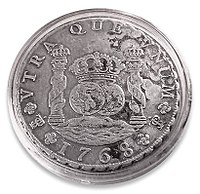
The symbol
Another popular explanation is that it is derived from the Pillars of Hercules on the Spanish Coat of arms of the Spanish dollar. These Pillars of Hercules on the silver Spanish dollar coins take the form of two vertical bars (||) and a swinging cloth band in the shape of an S.[citation needed]
Yet another explanation suggests that the dollar sign was formed from the capital letters U and S written or printed one on top of the other. This theory, popularized by novelist Ayn Rand in Atlas Shrugged,[33] does not consider the fact that the symbol was already in use before the formation of the United States.[34]
History
Origins: the Spanish dollar
The U.S. dollar was introduced at par with the Spanish-American silver dollar (or Spanish peso, Spanish milled dollar, eight-real coin, piece-of-eight). The latter was produced from the rich silver mine output of Spanish America, was minted in Mexico City, Potosí (Bolivia), Lima (Peru), and elsewhere, and was in wide circulation throughout the Americas, Asia, and Europe from the 16th to the 19th centuries. The minting of machine-milled Spanish dollars since 1732 boosted its worldwide reputation as a trade coin and positioned it to be the model for the new currency of the United States.[citation needed]
Even after the United States Mint commenced issuing coins in 1792, locally minted dollars and cents were less abundant in circulation than Spanish American pesos and reales; hence Spanish, Mexican, and American dollars all remained legal tender in the United States until the Coinage Act of 1857. In particular, colonists' familiarity with the Spanish two-real quarter peso was the reason for issuing a quasi-decimal 25-cent quarter dollar coin rather than a 20-cent coin.[citation needed]
For the relationship between the Spanish dollar and the individual state colonial currencies, see Connecticut pound, Delaware pound, Georgia pound, Maryland pound, Massachusetts pound, New Hampshire pound, New Jersey pound, New York pound, North Carolina pound, Pennsylvania pound, Rhode Island pound, South Carolina pound, and Virginia pound.[citation needed]
Coinage Act of 1792

On July 6, 1785, the Continental Congress resolved that the money unit of the United States, the dollar, would contain 375.64 grains of fine silver; on August 8, 1786, the Continental Congress continued that definition and further resolved that the money of account, corresponding with the division of coins, would proceed in a decimal ratio, with the sub-units being mills at 0.001 of a dollar, cents at 0.010 of a dollar, and dimes at 0.100 of a dollar.[14]
After the adoption of the
The same coinage act also set the value of an eagle at 10 dollars, and the dollar at 1⁄10 eagle. It called for silver coins in denominations of 1, 1⁄2, 1⁄4, 1⁄10, and 1⁄20 dollar, as well as gold coins in denominations of 1, 1⁄2 and 1⁄4 eagle. The value of gold or silver contained in the dollar was then converted into relative value in the economy for the buying and selling of goods. This allowed the value of things to remain fairly constant over time, except for the influx and outflux of gold and silver in the nation's economy.[36]
Though a Spanish dollar freshly minted after 1772 theoretically contained 417.7 grains of silver of fineness 130/144 (or 377.1 grains fine silver), reliable assays of the period in fact confirmed a fine silver content of 370.95 grains (24.037 g) for the average Spanish dollar in circulation. [37] The new U.S. silver dollar of 371.25 grains (24.057 g) therefore compared favorably and was received at par with the Spanish dollar for foreign payments, and after 1803 the United States Mint had to suspend making this coin out of its limited resources since it failed to stay in domestic circulation. It was only after Mexican independence in 1821 when their peso's fine silver content of 377.1 grains was firmly upheld, which the U.S. later had to compete with using a heavier 378.0 grains (24.49 g) Trade dollar coin.
Design
The early currency of the United States did not exhibit faces of presidents, as is the custom now;[38] although today, by law, only the portrait of a deceased individual may appear on United States currency.[39] In fact, the newly formed government was against having portraits of leaders on the currency, a practice compared to the policies of European monarchs.[40] The currency as we know it today did not get the faces they currently have until after the early 20th century; before that "heads" side of coinage used profile faces and striding, seated, and standing figures from Greek and Roman mythology and composite Native Americans. The last coins to be converted to profiles of historic Americans were the dime (1946), the half Dollar (1948), and the Dollar (1971).
Continental currency

After the American Revolution, the Thirteen Colonies became independent. Freed from British monetary regulations, they each issued £sd paper money to pay for military expenses. The Continental Congress also began issuing "Continental Currency" denominated in Spanish dollars. For its value relative to states' currencies, see Early American currency.
Continental currency
Silver and gold standards, 19th century
From implementation of the 1792
Subsequent to the Coinage Act of 1834 the dollar's fine gold equivalent was revised to 23.2 grains; it was slightly adjusted to 23.22 grains (1.505 g) in 1837 (gold-silver ratio ~16). The same act also resolved the difficulty in minting the "standard silver" of 89.24% fineness by revising the dollar's alloy to 412.5 grains, 90% silver, still containing 371.25 grains fine silver. Gold was also revised to 90% fineness: 25.8 grains gross, 23.22 grains fine gold.
Following the rise in the price of silver during the
Summary and links to coins issued in the 19th century:
- In base metal: 1/2 cent, 1 cent, 5 cents.
- In silver: half dime, dime, quarter dollar, half dollar, silver dollar.
- In gold: gold $1, $2.50 quarter eagle, $5 half eagle, $10 eagle, $20 double eagle.
- Less common denominations: .
Note issues, 19th century

In order to finance the War of 1812, Congress authorized the issuance of Treasury Notes, interest-bearing short-term debt that could be used to pay public dues. While they were intended to serve as debt, they did function "to a limited extent" as money. Treasury Notes were again printed to help resolve the reduction in public revenues resulting from the Panic of 1837 and the Panic of 1857, as well as to help finance the Mexican–American War and the Civil War.
Paper money was issued again in 1862 without the backing of precious metals due to the
Gold standard, 20th century
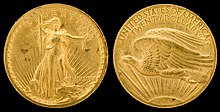
Though the dollar came under the gold standard de jure only after 1900, the bimetallic era was ended de facto when the Coinage Act of 1873 suspended the minting of the standard silver dollar of 412.5 Troy grains = 26.73 g; 0.859 ozt, the only fully legal tender coin that individuals could convert bullion into in unlimited (or Free silver) quantities,[a] and right at the onset of the silver rush from the Comstock Lode in the 1870s. This was the so-called "Crime of '73".
The
After 1968 a series of revisions to the gold peg was implemented, culminating in the
Federal Reserve Notes, 20th century to present
Congress continued to issue paper money after the Civil War, the latest of which is the
Emergence as reserve currency
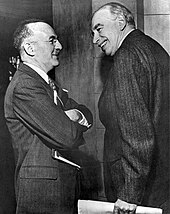
The U.S. dollar first emerged as an important international
The Bretton Woods Agreement of 1944 also defined the post-World War II monetary order and relations among modern-day independent states, by setting up a system of rules, institutions, and procedures to regulate the international monetary system. The agreement founded the International Monetary Fund and other institutions of the modern-day World Bank Group, establishing the infrastructure for conducting international payments and accessing the global capital markets using the U.S. dollar.
The
For most of the post-war period, the
Coins
The United States Mint has issued legal tender coins every year from 1792 to the present. From 1934 to the present, the only denominations produced for circulation have been the familiar penny, nickel, dime, quarter, half dollar, and dollar.
| Denomination | Common name | Obverse | Reverse | Obverse portrait and design date | Reverse motif and design date | Weight | Diameter | Material | Edge | Circulation |
|---|---|---|---|---|---|---|---|---|---|---|
| Cent 1¢ |
penny | Abraham Lincoln (1909) | Union Shield (2010) | 2.5 g (0.088 oz) |
0.75 in (19.05 mm) |
97.5% Zn covered by 2.5% Cu | Plain | Wide | ||
| Five cents 5¢ |
nickel | 
|

|
Thomas Jefferson (2006) | Monticello (1938) | 5.0 g (0.176 oz) |
0.835 in (21.21 mm) |
75% Cu 25% Ni |
Plain | Wide |
| Ten cents 10¢ |
dime | Franklin D. Roosevelt (1946) | Olive branch, torch, and oak branch (1946) | 2.268 g (0.08 oz) |
0.705 in (17.91 mm) |
91.67% Cu 8.33% Ni |
118 reeds | Wide | ||
| Quarter dollar 25¢ |
quarter | 
|

|
George Washington (1932) | Various (5 designs per year) | 5.67 g (0.2 oz) |
0.955 in (24.26 mm) |
91.67% Cu 8.33% Ni |
119 reeds | Wide |
| Half dollar 50¢ |
half dollar | 
|

|
John F. Kennedy (1964) | Presidential Seal (1964)
|
11.34 g (0.4 oz) |
1.205 in (30.61 mm) |
91.67% Cu 8.33% Ni |
150 reeds | Limited |
| Dollar coin $1 |
dollar coin, golden dollar | 
|

|
Sacagawea
(2000) |
Various (4 designs per year) | 8.10 g (0.286 oz) |
1.043 in (26.50 mm) |
88.5% Cu 6% Zn 3.5% Mn 2% Ni |
Plain 2000–2006 Lettered 2007–Present |
Limited |
| These images are to scale at 2.5 pixels per millimetre. For table standards, see the coin specification table. | ||||||||||
Gold and silver coins have been previously minted for general circulation from the 18th to the 20th centuries. The last gold coins were minted in 1933. The last 90% silver coins were minted in 1964, and the last 40% silver half dollar was minted in 1970.
The United States Mint currently produces circulating coins at the Philadelphia and Denver Mints, and commemorative and proof coins for collectors at the San Francisco and West Point Mints. Mint mark conventions for these and for past mint branches are discussed in Coins of the United States dollar#Mint marks.
The one-dollar coin has never been in popular circulation from 1794 to present, despite several attempts to increase their usage since the 1970s, the most important reason of which is the continued production and popularity of the one-dollar bill.[43] Half dollar coins were commonly used currency since inception in 1794, but has fallen out of use from the mid-1960s when all silver half dollars began to be hoarded.
The nickel is the only coin whose size and composition (5 grams, 75% copper, and 25% nickel) is still in use from 1865 to today, except for wartime 1942–1945 Jefferson nickels which contained silver.
Due to the penny's low value, some
For a discussion of other discontinued and canceled denominations, see Obsolete denominations of United States currency and Canceled denominations of United States currency.
Collector coins
Collector coins are technically legal tender at face value but are usually worth far more due to their numismatic value or for their precious metal content. These include:
- American Eagle bullion coins
- troy oz) Silver bullion coin 1986–present
- American Gold Eagle $5 (1⁄10 troy oz), $10 (1⁄4 troy oz), $25 (1⁄2 troy oz), and $50 (1 troy oz) Gold bullion coin 1986–present
- American Platinum Eagle $10 (1⁄10 troy oz), $25 (1⁄4 troy oz), $50 (1⁄2 troy oz), and $100 (1 troy oz) Platinum bullion coin 1997–present
- American Palladium Eagle $25 (1 troy oz) Palladium bullion coin 2017–present
- United States commemorative coins—special issue coins, among these:
- Panama-Pacific International Exposition (1915)
- Silver proof sets minted since 1992 with dimes, quarters and half-dollars made of silver rather than the standard copper-nickel
- Presidential dollar coins proof sets minted since 2007
Banknotes
| Denomination | Front | Reverse | Portrait | Reverse motif | First series | Latest series | Circulation |
|---|---|---|---|---|---|---|---|
| One dollar | 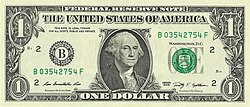
|

|
George Washington | Great Seal of the United States | Series 1963[b] Series 1935[c] |
Series 2017A[46] | Wide |
| Two dollars | 
|

|
Thomas Jefferson | Declaration of Independence by John Trumbull
|
Series 1976 | Series 2017A | Limited[47] |
| Five dollars | 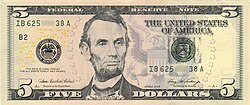
|
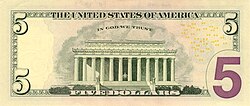
|
Abraham Lincoln | Lincoln Memorial | Series 2006 | Series 2021[48] | Wide |
| Ten dollars | 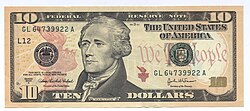
|
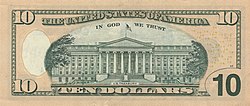
|
Alexander Hamilton | Treasury Building | Series 2004A | Series 2017A | Wide |
| Twenty dollars | 
|
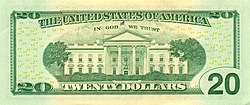
|
Andrew Jackson | White House | Series 2004 | Series 2017A | Wide |
| Fifty dollars | 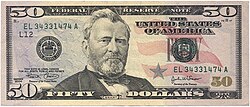
|
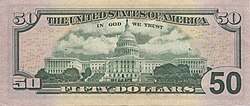
|
Ulysses S. Grant | United States Capitol | Series 2004 | Series 2017A | Wide |
One hundred dollars
|

|

|
Benjamin Franklin | Independence Hall | Series 2009A[49] | Series 2017A | Wide |
The
Though still predominantly green, the post-2004 series incorporate other colors to better distinguish different denominations. As a result of a 2008 decision in an accessibility lawsuit filed by the American Council of the Blind, the Bureau of Engraving and Printing is planning to implement a raised tactile feature in the next redesign of each note, except the $1 and the current version of the $100 bill. It also plans larger, higher-contrast numerals, more color differences, and distribution of currency readers to assist the visually impaired during the transition period.[d]
Countries that use US dollar
Formal
- United States of America
- including 5 territories: American Samoa, Guam, Northern Mariana Islands, Puerto Rico, United States Virgin Islands
- United States Minor Outlying Islands
- Compact of Free Association
- East Timor[57][e]
- Ecuador[58][f]
- El Salvador[59][g]
- Liberia[60][h]
- Panama[i]
- Zimbabwe[j]
Informal
Monetary policy
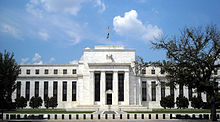
The
The Monetary policy of the United States is conducted by the Federal Open Market Committee, which is composed of the Federal Reserve Board of Governors and 5 out of the 12 Federal Reserve Bank presidents, and is implemented by all twelve regional Federal Reserve Banks.
Monetary policy refers to actions made by central banks that determine the size and growth rate of the money supply available in the economy, and which would result in desired objectives like low inflation, low unemployment, and stable financial systems. The economy's aggregate money supply is the total of
- M0 money, or Monetary Base – "dollars" in currency and bank moneybalances credited to the central bank's depositors, which are backed by the central bank's assets,
- plus M1, M2, M3 money – "dollars" in the form of bank moneybalances credited to banks' depositors, which are backed by the bank's assets and investments.
The FOMC influences the level of money available to the economy by the following means:
- Reserve requirements – specifies a required minimum percentage of deposits in a commercial bank that should be held as a reserve (i.e. as deposits with the Federal Reserve), with the rest available to loan or invest. Higher requirements mean less money loaned or invested, helping keep inflation in check. Raising the federal funds rate earned on those reserves also helps achieve this objective.
- Open market operations – the Federal Reserve buys or sells US Treasury bonds and other securities held by banks in exchange for reserves; more reserves increase a bank's capacity to loan or invest elsewhere.
- Discount window lending – banks can borrow from the Federal Reserve.
Monetary policy directly affects interest rates; it indirectly affects stock prices, wealth, and currency exchange rates. Through these channels, monetary policy influences spending, investment, production, employment, and inflation in the United States. Effective monetary policy complements fiscal policy to support economic growth.
The adjusted monetary base has increased from approximately $400 billion in 1994, to $800 billion in 2005, and to over $3 trillion in 2013.[67]
When the Federal Reserve makes a purchase, it credits the seller's reserve account (with the Federal Reserve). This money is not transferred from any existing funds—it is at this point that the Federal Reserve has created new
The Federal Reserve's monetary policy objectives to keep prices stable and unemployment low is often called the dual mandate. This replaces past practices under a
International use as reserve currency
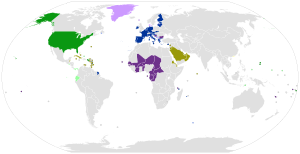
Ascendancy
The primary currency used for global trade between
The U.S. dollar began to displace the
As international reserve currency
The U.S. dollar is joined by the world's other major currencies – the euro, pound sterling, Japanese yen and Chinese renminbi – in the currency basket of the special drawing rights of the International Monetary Fund. Central banks worldwide have huge reserves of U.S. dollars in their holdings and are significant buyers of U.S. treasury bills and notes.[72]
Foreign companies, entities, and private individuals hold U.S. dollars in foreign deposit accounts called
The United States Department of the Treasury exercises considerable oversight over the SWIFT financial transfers network,[73] and consequently has a huge sway on the global financial transactions systems, with the ability to impose sanctions on foreign entities and individuals.[74]
In the global markets
The U.S. dollar is predominantly the standard currency unit in which goods are quoted and traded, and with which payments are settled in, in the global
The
A frequent topic of debate is whether the strong dollar policy of the United States is indeed in America's own best interests, as well as in the best interest of the international community.[78]
Currencies fixed to the U.S. dollar
For a more exhaustive discussion of countries using the U.S. dollar as official or customary currency, or using currencies which are pegged to the U.S. dollar, see International use of the U.S. dollar#Dollarization and fixed exchange rates and Currency substitution#US dollar.
Countries using the U.S. dollar as their official currency include:
- In the Americas: Panama, Ecuador, El Salvador, British Virgin Islands, Turks and Caicos Islands, and the Caribbean Netherlands.
- The constituent states of the former Trust Territory of the Pacific Islands: Palau, the Federated States of Micronesia, and the Marshall Islands.
- Others: East Timor.
Among the countries using the U.S. dollar together with other foreign currencies and their local currency are Cambodia and Zimbabwe.
Currencies pegged to the U.S. dollar include:
- In the Caribbean: the Bahamian dollar, Barbadian dollar, Belize dollar, Bermudian dollar, Cayman Islands dollar, Eastern Caribbean dollar, Netherlands Antillean guilder and the Aruban florin.
- The currencies of five oil-producing Arab countries: the Saudi riyal, United Arab Emirates dirham, Omani rial, Qatari riyal and the Bahraini dinar.
- Others: the Hong Kong dollar, Macanese pataca, Jordanian dinar, Lebanese pound.
Value
This section needs to be updated. The reason given is: No new data from the past 12 years (ignoring the difficult to read graphs up to 2021 labeled "Inflation of the dollar"), but prices of many foods along have increased 2-4x or more as one example, but pay isn't increasing at all for most people. The actual inflation numbers would be interesting.. (April 2024) |
|
|
|

The 6th paragraph of
The table above shows the equivalent amount of goods that, in a particular year, could be purchased with $1. The table shows that from 1774 through 2012 the U.S. dollar has lost about 97.0% of its buying power.[80]
The decline in the value of the U.S. dollar corresponds to
The value of the U.S. dollar declined significantly during wartime, especially during the
Under the Bretton Woods system established after World War II, the value of gold was fixed to $35 per ounce, and the value of the U.S. dollar was thus anchored to the value of gold. Rising government spending in the 1960s, however, led to doubts about the ability of the United States to maintain this convertibility, gold stocks dwindled as banks and international investors began to convert dollars to gold, and as a result, the value of the dollar began to decline. Facing an emerging currency crisis and the imminent danger that the United States would no longer be able to redeem dollars for gold, gold convertibility was finally terminated in 1971 by President Nixon, resulting in the "Nixon shock".[87]
The value of the U.S. dollar was therefore no longer anchored to gold, and it fell upon the Federal Reserve to maintain the value of the U.S. currency. The Federal Reserve, however, continued to increase the money supply, resulting in stagflation and a rapidly declining value of the U.S. dollar in the 1970s. This was largely due to the prevailing economic view at the time that inflation and real economic growth were linked (the Phillips curve), and so inflation was regarded as relatively benign.[87] Between 1965 and 1981, the U.S. dollar lost two thirds of its value.[80]
In 1979,
Over the thirty-year period from 1981 to 2009, the U.S. dollar lost over half its value.[80] This is because the Federal Reserve has targeted not zero inflation, but a low, stable rate of inflation—between 1987 and 1997, the rate of inflation was approximately 3.5%, and between 1997 and 2007 it was approximately 2%. The so-called "Great Moderation" of economic conditions since the 1970s is credited to monetary policy targeting price stability.[88]
There is an ongoing debate about whether central banks should target zero inflation (which would mean a constant value for the U.S. dollar over time) or low, stable inflation (which would mean a continuously but slowly declining value of the dollar over time, as is the case now). Although some economists are in favor of a zero inflation policy and therefore a constant value for the U.S. dollar,
Pegged currencies
- Aruban florin (lower value)
- Bahamian dollar (at par)
- Bahraini dinar (higher value)
- Barbadian dollar (lower value)
- Belarusian ruble (alongside Euro and Russian ruble in currency basket)
- Belize dollar (lower value)
- Bermudian dollar (at par)
- Bolivian boliviano (lower value)
- Cambodian riel (lower value)
- Cayman Islands dollar (higher value)
- Costa Rican colón (lower value)
- Cuban peso (lower value)
- Eastern Caribbean dollar (lower value)
- East Timor centavo coins (at par)
- Ecuadorian centavo coins (at par)
- Salvadoran colón (lower value)
- Eritrean nakfa (lower value)
- Guatemalan quetzal (lower value)
- Haitian gourde (lower value)
- Honduran lempira (lower value)
- Hong Kong dollar (narrow band)
- Iraqi dinar (lower value)
- Jordanian dinar (higher value)
- Kuwaiti dinar (higher value)
- Lebanese pound (lower value)
- Netherlands Antillean guilder (lower value, scheduled to be abolished in 2025)
- Nicaraguan córdoba (lower value)
- Nigerian naira (lower value)
- Omani rial (higher value)
- Panamanian balboa (at par)
- Qatari riyal (lower value)
- Saudi riyal (lower value)
- Sierra Leonean leone (lower value)
- Trinidad and Tobago dollar (lower value)
- United Arab Emirates dirham
- Yemeni rial (lower value)
- Zimbabwean bond coins and bond notes (at par)
Exchange rates

Historical exchange rates
| Currency units | 1970[i] | 1980[i] | 1985[i] | 1990[i] | 1993 | 1999 | 2000 | 2001 | 2002 | 2003 | 2004 | 2005 | 2006 | 2007 | 2008 | 2009 | 2010 | 2011 | 2012 | 2013 | 2014 | 2015 | 2018[94] |
|---|---|---|---|---|---|---|---|---|---|---|---|---|---|---|---|---|---|---|---|---|---|---|---|
| Euro | — | — | — | — | — | 0.9387 | 1.0832 | 1.1171 | 1.0578 | 0.8833 | 0.8040 | 0.8033 | 0.7960 | 0.7293 | 0.6791 | 0.7176 | 0.6739 | 0.7178 | 0.7777 | 0.7530 | 0.7520 | 0.9015 | 0.8504 |
| Japanese yen | 357.6 | 240.45 | 250.35 | 146.25 | 111.08 | 113.73 | 107.80 | 121.57 | 125.22 | 115.94 | 108.15 | 110.11 | 116.31 | 117.76 | 103.39 | 93.68 | 87.78 | 79.70 | 79.82 | 97.60 | 105.74 | 121.05 | 111.130 |
| Pound sterling | 8s 4d =0.4167 |
0.4484[ii] | 0.8613[ii] | 0.6207 | 0.6660 | 0.6184 | 0.6598 | 0.6946 | 0.6656 | 0.6117 | 0.5456 | 0.5493 | 0.5425 | 0.4995 | 0.5392 | 0.6385 | 0.4548 | 0.6233 | 0.6308 | 0.6393 | 0.6066 | 0.6544 | 0.7454 |
| Swiss franc | 4.12 | 1.68 | 2.46[95] | 1.39 | 1.48 | 1.50 | 1.69 | 1.69 | 1.62 | 1.40 | 1.24 | 1.15 | 1.29 | 1.23 | 1.12 | 1.08 | 1.03 | 0.93 | 0.93 | 0.90 | 0.92 | 1.00 | 0.98 |
| Canadian dollar[96] | 1.081 | 1.168 | 1.321 | 1.1605 | 1.2902 | 1.4858 | 1.4855 | 1.5487 | 1.5704 | 1.4008 | 1.3017 | 1.2115 | 1.1340 | 1.0734 | 1.0660 | 1.1412 | 1.0298 | 0.9887 | 0.9995 | 1.0300 | 1.1043 | 1.2789 | 1.2842 |
| Mexican peso[97] | 0.01250–0.02650[iii] | 2.80[iii] | 2.67[iii] | 2.50[iii] | 3.1237 | 9.553 | 9.459 | 9.337 | 9.663 | 10.793 | 11.290 | 10.894 | 10.906 | 10.928 | 11.143 | 13.498 | 12.623 | 12.427 | 13.154 | 12.758 | 13.302 | 15.837 | 19.911 |
| Chinese Renminbi[98] | 2.46 | 1.7050 | 2.9366 | 4.7832 | 5.7620 | 8.2783 | 8.2784 | 8.2770 | 8.2771 | 8.2772 | 8.2768 | 8.1936 | 7.9723 | 7.6058 | 6.9477 | 6.8307 | 6.7696 | 6.4630 | 6.3093 | 6.1478 | 6.1620 | 6.2840 | 6.383 |
| Pakistani rupee | 4.761 | 9.9 | 15.9284 | 21.707 | 28.107 | 51.9 | 51.9 | 63.5 | 60.5 | 57.75 | 57.8 | 59.7 | 60.4 | 60.83 | 67 | 80.45 | 85.75 | 88.6 | 90.7 | 105.477 | 100.661 | 104.763 | 139.850 |
| Singapore dollar | — | — | 2.179 | 1.903 | 1.6158 | 1.6951 | 1.7361 | 1.7930 | 1.7908 | 1.7429 | 1.6902 | 1.6639 | 1.5882 | 1.5065 | 1.4140 | 1.4543 | 1.24586 | 1.2565 | 1.2492 | 1.2511 | 1.2665 | 1.3748 | 1.343 |
| South Korean won | 310.556 | 607.717 | 870.020 | 707.766 | 802.538 | 1189.439 | 1130.362 | 1290.790 | 1251.602 | 1191.646 | 1146.249 | 1024.328 | 955.341 | 929.376 | 1100.126 | 1277.246 | 1156.460 | 1108.233 | 1126.807 | 1094.983 | 1052.840 | 1130.953 | 1100.163 |
Current exchange rates
| Current USD exchange rates | |
|---|---|
| From Google Finance: | AUD CAD CHF CNY EUR GBP HKD JPY CAD TWD KRW |
| From Yahoo! Finance: | AUD CAD CHF CNY EUR GBP HKD JPY CAD TWD KRW |
| From XE.com: | AUD CAD CHF CNY EUR GBP HKD JPY CAD TWD KRW |
| From OANDA: | AUD CAD CHF CNY EUR GBP HKD JPY CAD TWD KRW |
See also
- Counterfeit United States currency
- Dedollarisation
- Currency substitution
- International use of the U.S. dollar
- List of the largest trading partners of the United States
- Monetary policy of the United States
- Petrodollar recycling
- Strong dollar policy
- U.S. Dollar Index
- Virtual currency
Notes
- ^ Silver bullion can be converted in unlimited quantities of Trade dollars of 420 grains, but these were meant for export and had legal tender limits in the US. See Trade dollar (United States coin).
- ^ Obverse
- ^ Reverse
- ^ See Federal Reserve Note for details and references.
- ^ Alongside East Timor centavo coins
- ^ Alongside Ecuadorian centavo coins
- ^ Alongside Bitcoin
- ^ Alongside Liberian dollar
- ^ Alongside Panamanian balboa
- Zimdollar
- ^ a b c Kingdom of the Netherlands
- ^ a b c United Kingdom of Great Britain and Northern Ireland
- ^ Alongside Pound sterling
- ^ Alongside Cambodian riel
- Venezuelan Bolivar
- ^ a b c d Mexican peso values prior to 1993 revaluation
- ^ a b 1970–1992 Archived October 23, 2018, at the Wayback Machine. 1980 derived from AUD–USD=1.1055 and AUD–GBP=0.4957 at end of Dec 1979: 0.4957/1.1055=0.448394392; 1985 derived from AUD–USD=0.8278 and AUD–GBP=0.7130 at end of Dec 1984: 0.7130/0.8278=0.861319159.
- ^ a b c d Value at the start of the year
References
- ^ "Coinage Act of 1792" (PDF). United States Congress. Archived from the original (PDF) on April 7, 2004. Retrieved April 2, 2008.
- ^ "Nixon Ends Convertibility of US Dollars to Gold and Announces Wage/Price Controls". Federal Reserve Bank of Richmond. Archived from the original on November 20, 2020. Retrieved October 17, 2018.
- ^ "The Implementation of Monetary Policy – The Federal Reserve in the International Sphere" (PDF). Archived (PDF) from the original on April 27, 2017. Retrieved October 17, 2018.
- ISBN 0-691-11666-0.
- ISBN 0-471-79816-9. p. 17: "the dollar is the de facto currency in Cambodia."
- ^ "How much U.S. currency is in circulation?". Federal Reserve. Archived from the original on November 13, 2021. Retrieved February 27, 2021.
- ^ "Federal Reserve Balance Sheet: Factors Affecting Reserve Balances - H.4.1". September 21, 2023. Archived from the original on October 4, 2023.
- ^ U.S. Constitution, Article 1, Section 8. para. 5 Archived November 18, 2021, at the Wayback Machine.
- ^ a b c Denominations, specifications, and design of coins. 31 U.S.C. § 5112.
- ^ U.S. Constitution, Article 1, Section 9. para. 7 Archived November 18, 2021, at the Wayback Machine.
- ^ Reports. 31 U.S.C. § 331.
- ^ "Financial Report of the United States Government" (PDF). Department of the Treasury. 2009. Archived from the original (PDF) on November 13, 2018. Retrieved October 17, 2018.
- ^ a b U.S. Congress. 1792. Coinage Act of 1792. 2nd Congress, 1st Session. Sec. 9, ch. 16. Retrieved June 6, 2020.
- ^ a b Fitzpatrick, John C., ed. (1934). "Tuesday, August 8, 1786". Journals of the Continental Congress 1774–1789. XXXI: 1786: 503–505. Archived from the original on May 7, 2021. Retrieved December 5, 2019.
- ^ Peters, Richard, ed. (1845). "Second Congress. Sess. I. Ch. 16". The Public Statutes at Large of the United States of America, Etc. Etc. 1: 246–251. Archived from the original on November 13, 2020. Retrieved December 5, 2019.
- ^ Langland, Connie (May 27, 2015). "What is a millage rate and how does it affect school funding?". WHYY. PBS and NPR. Archived from the original on March 7, 2021. Retrieved December 5, 2019.
- ^ a b "Mills Currency". Past & Present. Stamp and Coin Place Blog. September 26, 2018. Archived from the original on May 3, 2021. Retrieved December 5, 2019.
- ^ a b "How much is "two bits" and where did the phrase". Archived from the original on August 14, 2021. Retrieved June 9, 2021.
- ^ "Decimal Trading Definition and History". Archived from the original on November 18, 2021. Retrieved June 10, 2021.
- ^ Mehl, B. Max. "United States $50.00 Gold Pieces, 1877", in Star Rare Coins Encyclopedia and Premium Catalogue (20th edition, 1921)
- ^ a b "Ask US." National Geographic. June 2002. p. 1.
- ^ There is no solid reference on the desirability of liondollars in North America and on 1:1 parity with heavier dollars. A dollar worth $0.80 Spanish is not cheap if priced at $0.50 http://coins.lakdiva.org/netherlands/1644_wes_lion_daalder_ag.html Archived February 5, 2013, at the Wayback Machine https://coins.nd.edu/ColCoin/ColCoinIntros/Lion-Dollar.intro.html Archived July 10, 2018, at the Wayback Machine
- ^ "Buck". Online Etymology Dictionary. Retrieved October 17, 2018.
- ^ "Paper Money Glossary". Littleton Coin Company. Archived from the original on October 18, 2018. Retrieved October 17, 2018.
- ^ Scutt, David (June 3, 2019). "The Australian dollar is grinding higher as expectations for rate cuts from the US Federal Reserve build". Business Insider. Archived from the original on August 7, 2019. Retrieved August 7, 2019.
- ^ Tappe, Anneken (August 9, 2018). "New Zealand dollar leads G-10 losers as greenback gains strength". MarketWatch. Archived from the original on August 7, 2019. Retrieved August 7, 2019.
- ^ "UPDATE 1-South Africa's rand firms against greenback, stocks rise". Reuters. Retrieved August 7, 2019.[dead link]
- ^ "Why rupee is once again under pressure". Business Today. April 22, 2019. Retrieved August 7, 2019.[permanent dead link]
- ISBN 0-486-67766-4
- JSTOR 2506275.
- ^ Nussbaum, Arthur (1957). A History of the Dollar. New York: Columbia University Press. p. 56.
The dollar sign, $, is connected with the peso, contrary to popular belief, which considers it to be an abbreviation of 'U.S.' The two parallel lines represented one of the many abbreviations of 'P,' and the 'S' indicated the plural. The abbreviation '$.' was also used for the peso, and is still used in Argentina.
- ^ "U.S. Bureau of Engraving and Printing – FAQs". www.bep.gov. Archived from the original on October 18, 2018. Retrieved October 17, 2018.
- ^ Rand, Ayn. [1957] 1992. Atlas Shrugged. Signet. p. 628.
- ISBN 978-0-8369-5527-9.
- ^ Mint, U.S. (April 6, 2017). "Coinage Act of 1792". U.S. treasury. Archived from the original on November 8, 2020. Retrieved October 17, 2018.
- ^ Mason, Seth (January 7, 2013). "The Definitive Inflation Chart". Ecominoes. Archived from the original on October 19, 2018..
- from the original on April 9, 2022. Retrieved June 7, 2021.
- ^ "United States Dollar". OANDA. Archived from the original on October 18, 2018. Retrieved October 17, 2018.
- ^ "Engraving and printing currency and security documents:Article b". Legal Information Institute. Archived from the original on December 20, 2013. Retrieved December 19, 2013.
- ^ Matt Soniak (July 22, 2011). "On the Money: Everything You Ever Wanted to Know About Coin Portraits". Mental Floss. Retrieved October 17, 2018.
- ISBN 0-87341-120-X.
- ISBN 978-0-07-154393-4.
- CNN Money.
- ^ Christian Zappone (July 18, 2006). "Kill-the-penny bill introduced". CNN Money. Archived from the original on July 28, 2019. Retrieved October 17, 2018.
- ^ Weinberg, Ali (February 19, 2013). "Penny pinching: Can Obama manage elimination of one-cent coin?". NBC News. Archived from the original on October 18, 2018. Retrieved October 17, 2018.
- ^ "USPaperMoney.Info: Series 2017A $1". www.uspapermoney.info. Archived from the original on February 21, 2020. Retrieved February 7, 2020.
- ^ Meyersohn, Nathaniel (September 20, 2022). "Why it's time to start paying with $2 bills". CNN. Retrieved February 6, 2024.
- ^ "5 Dollars (Federal Reserve Note; colored) - United States". Archived from the original on June 7, 2023. Retrieved June 7, 2023.
- ^ "$100 Note | U.S. Currency Education Program". Archived from the original on August 20, 2020. Retrieved April 22, 2021.
- ^ "Paragraph 2 of Section 8 of Article 1 of the United States Constitution". Topics.law.cornell.edu. Archived from the original on November 18, 2021. Retrieved October 17, 2018.
- ^ "Section 411 of Title 12 of the United States Code". Law.cornell.edu. June 22, 2010. Archived from the original on June 27, 2019. Retrieved October 17, 2018.
- ^ "Section 5103 of Title 31 of the United States Code". Law.cornell.edu. August 6, 2010. Archived from the original on October 22, 2018. Retrieved October 17, 2018.
- ^ "Section 5115 of Title 31 of the United States Code". Law.cornell.edu. August 6, 2010. Archived from the original on June 27, 2019. Retrieved October 17, 2018.
- ^ "Treasury Department Appropriation Bill for 1929: Hearing Before the Subcommittee of House Committee on Appropriations... Seventieth Congress, First Session". 1928.
- ISBN 9781440225789.
- ^ Orzano, Michele (February 25, 2015). "What is a horse blanket note?". Coin World. Archived from the original on November 29, 2021.
- ^ "Central Bank of Timor-Leste". Archived from the original on May 1, 2019. Retrieved March 22, 2017.
The official currency of Timor-Leste is the United States dollar, which is legal tender for all payments made in cash.
- CIA World Factbook. October 18, 2010. Archivedfrom the original on January 10, 2021. Retrieved October 17, 2018.
The dollar is legal tender
- CIA World Factbook. October 21, 2010. Archivedfrom the original on May 7, 2021. Retrieved October 17, 2018.
The US dollar became El Salvador's currency in 2001
- ^ "Currency". Central Bank of Liberia. Archived from the original on January 15, 2023. Retrieved January 15, 2023.
- ^ Nay Im, Tal; Dabadie, Michel (March 31, 2007). "Dollarization in Cambodia" (PDF). National Bank of Cambodia. Archived (PDF) from the original on May 11, 2022. Retrieved April 11, 2022.
- ^ Nagumo, Jada (August 4, 2021). "Cambodia aims to wean off US dollar dependence with digital currency". Nikkei Asia. Archived from the original on April 15, 2022. Retrieved April 11, 2022.
Cambodia runs a dual-currency system, with the U.S. dollar widely circulating in its economy. The country's dollarization began in the 1980s and 90s, following years of civil war and unrest.
- ^ Zerpa, Fabiola (November 5, 2019). "Venezuela Is Now More Than 50% Dollarized, Study Finds". Bloomberg. Retrieved November 9, 2019.
- ^ "Maduro says 'thank God' for dollarization in Venezuela". Reuters. November 17, 2019. Retrieved November 18, 2019.
- ^ "Federal Reserve Board – Purposes & Functions". Archived from the original on March 26, 2020. Retrieved June 11, 2021.
- ^ "Conducting Monetary Policy" (PDF). United States Federal Reserve. Archived (PDF) from the original on August 11, 2021. Retrieved August 23, 2021.
- ^ "St. Louis Adjusted Monetary Base". Federal Reserve Bank of St. Louis. February 15, 1984. Archived from the original on October 17, 2018. Retrieved October 17, 2018.
- ^ "Fact Sheets: Currency & Coins". United States Department of the Treasury. Archived from the original on October 18, 2018. Retrieved October 17, 2018.
- ^ "'The Silver Way' Explains How the Old Mexican Dollar Changed the World". April 30, 2017. Archived from the original on May 16, 2021. Retrieved June 8, 2021.
- from the original on January 7, 2023. Retrieved April 16, 2021.
- ^ "How a 1944 Agreement Created a New World Order". Archived from the original on May 20, 2021. Retrieved June 8, 2021.
- ^ "MAJOR FOREIGN HOLDERS OF TREASURY SECURITIES". US Treasury. March 15, 2023. Archived from the original on November 23, 2010. Retrieved May 22, 2023.
- ^ "SWIFT oversight". Archived from the original on June 16, 2023. Retrieved June 8, 2021.
- ^ "Sanctions Programs and Country Information | U.S. Department of the Treasury". Archived from the original on June 16, 2023. Retrieved June 8, 2021.
- ^ "Impact of the Dollar on Commodity Prices". Archived from the original on March 1, 2023. Retrieved June 8, 2021.
- ^ "Dollar Bond". Archived from the original on June 8, 2021. Retrieved June 8, 2021.
- ^ Bernanke, Ben S. (January 7, 2016). "The dollar's international role: An "exorbitant privilege"?". Archived from the original on June 8, 2021.
- ^ Mohsin, Saleha (January 21, 2021). "The Strong Dollar". Bloomberg. Archived from the original on August 22, 2021. Retrieved August 23, 2021.
- ^ "Section 9 of the Coinage Act of 1792". American Memory - Library of Congress. Archived from the original on July 29, 2020. Retrieved August 24, 2010.
- ^ a b c "Measuring Worth – Purchasing Power of Money in the United States from 1774 to 2010". Archived from the original on June 16, 2023. Retrieved April 22, 2010.
- ISBN 0-13-013306-X
- ^ "Consumer Price Index Frequently Asked Questions". Archived from the original on October 18, 2018. Retrieved October 16, 2018.
- ^ "Consumer Price Index Frequently Asked Questions". Archived from the original on October 18, 2018. Retrieved October 17, 2018.
- ISBN 978-0691003542.
- ^ Friedman 189–190
- ^ a b Broaddus Jr., J. Alfred (September 1, 1993). "Central Banking—Then and Now". Federal Reserve Bank of Minneapolis. Archived from the original on October 26, 2018. Retrieved October 17, 2018.
- ^ a b c Emery, Kenneth M. "Controlling Inflation: A Historical Perspective" (PDF). Federal Reserve Bank of Dallas. Archived from the original (PDF) on December 7, 2010. Retrieved July 17, 2010.
- ^ Ferguson, Roger W. Jr. (November 3, 2005). "Monetary Credibility, Inflation, and Economic Growth". FRB. Archived from the original on August 15, 2010. Retrieved July 17, 2010.
- ^ "What are the goals of U.S. monetary policy?". Federal Reserve Bank of San Francisco. February 6, 2004. Archived from the original on October 18, 2018. Retrieved October 17, 2018.
- ^ U.S. Federal Reserve: Last 4 years Archived October 18, 2018, at the Wayback Machine, 2009–2012 Archived October 18, 2018, at the Wayback Machine, 2005–2008 Archived October 18, 2018, at the Wayback Machine, 2001–2004 Archived October 18, 2018, at the Wayback Machine, 1997–2000 Archived October 18, 2018, at the Wayback Machine, 1993–1996 Archived October 18, 2018, at the Wayback Machine; Reserve Bank of Australia: 1970–present Archived October 23, 2018, at the Wayback Machine
- ^ "2004–present". Archived from the original on July 23, 2014. Retrieved July 24, 2014.
- ^ "FRB: Foreign Exchange Rates – G.5A; Release Dates". Board of Governors of the Federal Reserve System. Archived from the original on August 3, 2014. Retrieved July 23, 2014.
- ^ "Exchange rates". OECD.
- ^ "Historical Exchange Rates Currency Converter". TransferMate.com. Archived from the original on September 18, 2016. Retrieved September 10, 2016.
- ^ "Exchange Rates Between the United States Dollar and the Swiss Franc Archived March 30, 2019, at the Wayback Machine." Measuring Worth. Retrieved October 17, 2018.
- ^ 1977–1991
- ^ 1976–1991
- ^ 1974–1991, 1993–1995
Further reading
- Prasad, Eswar S. (2014). The Dollar Trap: How the U.S. Dollar Tightened Its Grip on Global Finance. Princeton, NJ: ISBN 978-0-691-16112-9.
External links
- U.S. Bureau of Engraving and Printing Archived May 30, 1997, at the Wayback Machine
- U.S. Currency and Coin Outstanding and in Circulation
- American Currency Exhibit at the San Francisco Federal Reserve Bank
- Relative values of the U.S. dollar, from 1774 to present
- Historical Currency Converter
- Summary of BEP Production Statistics
- The U.S. Currency Education Program


